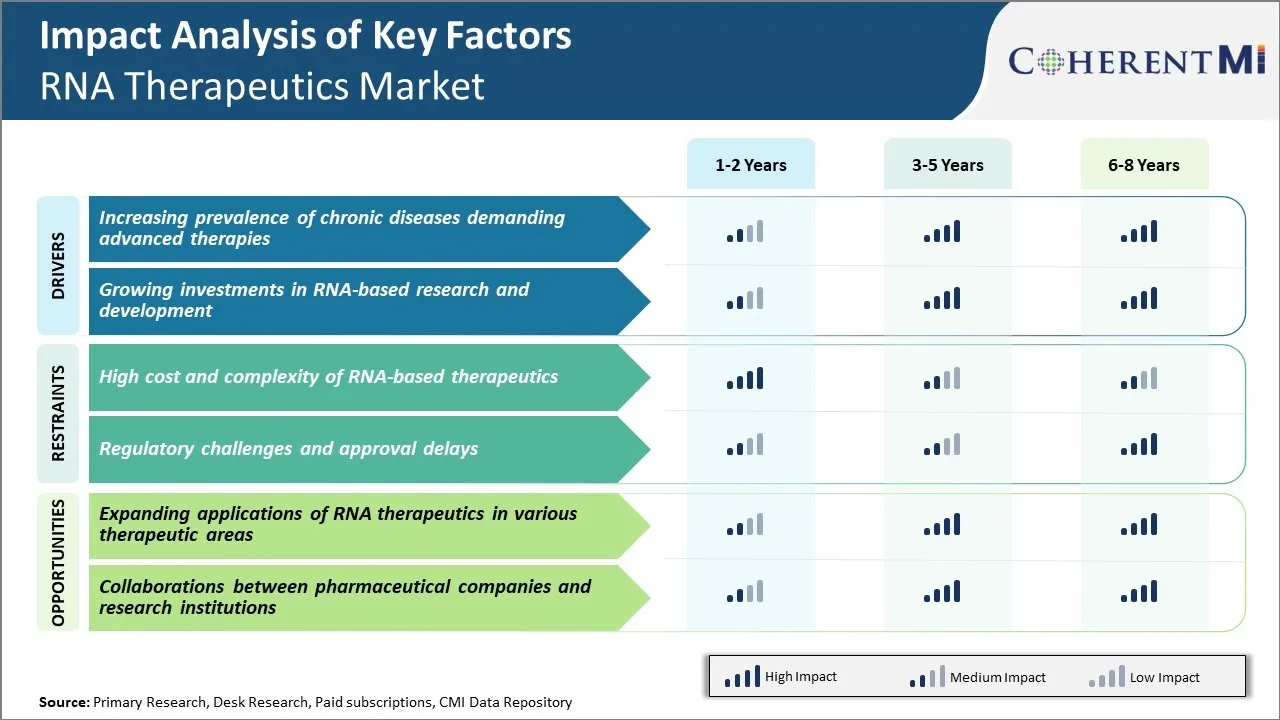RNA Therapeutics Market Trends
Market Driver - Increasing Prevalence of Chronic Diseases Demanding Advanced Therapies
The growing burden of chronic diseases across the world has become a major healthcare challenge. Diseases like cancer, cardiovascular diseases, neurodegenerative disorders are affecting millions of lives. As per WHO, chronic diseases account for over 70% deaths globally each year. The need to effectively treat these complex diseases has accelerated the search for advanced disease modifying therapies.
RNA therapeutics is emerging as one of the most promising areas that can help address unmet needs in chronic disease management. Disease pathogenesis at molecular level involves various genetic and RNA expressions. Traditional drug molecules are not always able to target these underlying abnormalities precisely. RNA-based drugs offer targeted approach to intervene at RNA level and correct the causes of diseases. Technologies like RNA interference (RNAi), antisense oligonucleotides are enabling design of therapies against previously undruggable targets.
Success stories of RNA drugs in clinical trials are boosting industry's confidence in their potential. Patisiran became first RNAi drug approved by FDA for hereditary transthyretin-mediated amyloidosis. Investigational RNA drugs are showing encouraging results for conditions like spinal muscular atrophy, Duchenne muscular dystrophy. As disease understanding improves through research, more RNA drug targets are being identified. This expanding target pipeline is likely to increase success rates of future RNA drug developments.
Market Driver - Growing Investments in RNA-based Research and Development
Advancements in basic research have tremendously increased understanding of biological functions at molecular level involving RNA. This expanding knowledge base is continuously fueling innovation in RNA technologies. Significant number of investments are allowing companies to explore RNA's applications beyond traditional drug development.
Venture capital firms and healthcare investors see immense long-term potential in RNA as a new therapeutic class. Global funding in RNA-based companies exceeded US$ 2.5 Billion in 2021 alone. Several biotech startups focused exclusively on RNA are able to raise large Series A/B rounds indicating investor confidence. Big pharmaceutical players are also actively partnering and acquiring small RNA companies to build capabilities in this area.
In addition to private money, governments and not-for-profit organizations are majorly supporting RNA research through dedicated grants. National Institutes of Health, European Commission and other global health organizations consider RNA an important long term priority area. Their sustained funding is propelling important basic researches, facilitating collaborations and helping build infrastructure.
Growing R&D activity is expanding therapeutic applications of RNA concepts beyond drug development. RNA is being researched for complex gene editing, cell and gene therapy, diagnostics etc. Rapid technology convergence with fields like artificial intelligence, genome sequencing is opening up newer avenues. These multi-disciplinary innovations will create wider commercialization opportunities augmenting the attractiveness of RNA sector.

Market Challenge - High Cost and Complexity of RNA-based Therapeutics
One of the key challenges in the RNA therapeutics market is the high cost and complexity associated with RNA-based drugs. Developing RNA therapies requires sophisticated delivery technologies to effectively deliver nucleic acids such as mRNA to target cells and tissues. The delivery vehicles need to protect the fragile RNA strands from degradation or improper functioning in the body. This adds significantly to the overall development costs of RNA drugs. Furthermore, manufacturing RNA drugs at commercial scale also poses technical challenges. Mass producing therapeutic nucleic acids with required purity and quality needs specialized equipment and expertise. All these factors contribute to making RNA drugs much more expensive to develop and produce than conventional small-molecule drugs. The costs are further increased due to the need for life-long treatments for chronic conditions with RNA therapeutics. Additionally, the complex nature of these molecules means they have a relatively short shelf life requiring careful handling and storage. This complexity and the specialized manufacturing needs of RNA drugs keep them from being affordable and accessible to a majority of patients globally. Overcoming these challenges remains a key priority for players in this segment to realize the full potential of this innovative class of therapeutics.
Market Opportunity - Expanding Applications of RNA Therapeutics in Various Therapeutic Areas
One of the key opportunities for growth in the RNA therapeutics market is the expanding range of applications that these drugs are targeting. Traditionally, RNA drugs were majorly focused on genetic diseases for conditions where replacing or modifying a protein could offer therapeutic benefits. However, ongoing research success has opened up new avenues. RNA technologies are now being explored for developing treatments in more prevalent therapeutic areas like oncology, cardiology, metabolic disorders, pain management and vaccines. Considering the large patient pools and worldwide burden of diseases in these areas, RNA drugs effectively developed here could cater to massive markets.
Additionally, the programmability of RNA allows developing personalized treatments targeting specific mutations or biomarkers of diseases. This brings the possibility of effective and tailored therapies for subgroups within disease conditions. With advancements reducing manufacturing and delivery complexities, more disease applications are expected to be added, thereby majorly boosting the commercial potential of the RNA therapeutics sector over the coming years.